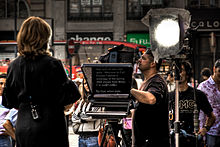Prompt
The prompter , also called teleprompter (English for " prompter "; from Latin promptus "resolute, ready"), sometimes also Autocue (brand name of the English company of the same name), is a technical aid that is used primarily in television productions , less often in film productions and lectures and talking is used to create eye contact and free speech in the viewer .
functionality
In the television studio, a monitor is mounted under the camera lens to display the text. Because of the mirror, this teleprompter image has to be electronically "turned upside down".
The presenter can read it through a one-way mirror in front of the lens without taking his eyes off the camera . The quality of the camera image is only insignificantly influenced by this device, the impairment can easily be compensated for by the camera. A cladding ensures - from the speaker's point of view - an evenly dark background and prevents light falling from the side from being reflected into the lens.
For lectures and speeches, two lightly tinted glass panes are mounted on stands in the right and left areas of the speaker's field of vision, the associated monitors or projectors are on the floor. In this way, the speaker can address the whole audience by constantly turning his head, and on the other hand there is an unobstructed view in the middle for cameras of the press.
Originally, the text was typed with ordinary typewriters on special, approx. 10 cm wide strips of paper. These were pulled past in the studio with a hand crank or motor under a special macro camera, the speed was controlled by the moderator himself (usually with foot control) or an operator.
In modern systems, the text comes from databases and is automatically formatted by special software (for relaxed reading) to a maximum of 30 characters per line. Often this also allows the speaker to add emphasis marks, which are automatically removed when the device is used again (for example, for use on the Internet).
Speaker training
For viewers, speakers who read from a prompt can be recognized by their eyes, which are constantly moving from right to left. This can be irritating, especially for beginners, as the speaker appears “distracted”. In speaker training, therefore, a special cognitive technique is trained in which the eyes do not “wander” while reading: Similar to a technical cache memory , whole lines are optically captured in about a tenth of a second and “temporarily” stored in the head; the eyes are relaxed during the 1.5 to 2 seconds when speaking the line.
philosophy
At ARD-aktuell , teleprompters were rejected for a long time on the grounds that the full-time speakers (typically with actor training) could memorize the texts and would be too restricted in their facial expressions by reading them: After all, a speaker who gives a free speech does not always look straight in the eye of his listener. At ZDF - with journalists in the studio - the teleprompter, on the other hand, was introduced as early as the 1970s.
history
The American Hubert Schlafly (1919–2011) invented the teleprompter in the 1950s together with Irving B. Kahn .
Prompters have been built and used since the 1950s.
Simple boards with text to read have been known since the early years of the sound film and were called " niggers" . Hans Albers and Marlon Brando are said to have been heavily dependent on this aid.
Web links
- Explanation of the functionality of conference teleprompter systems (German)
- Instructions for a self-made teleprompter (English)
Individual evidence
- ^ The Guardian: Hubert Schlafly, inventor of the teleprompter, dies aged 91
- ^ New York Times: Hubert Schlafly, Who Helped Build Teleprompter, Is Dead at 91
- ↑ historical information on a manufacturer's website , accessed on December 14, 2011
- ↑ http://filmlexikon.uni-kiel.de/index.php?action=lexikon&tag=det&id=953
- ↑ https://www.focus.de/kultur/medien/fernsehen-fauler-sprechzauber_aid_178232.html





